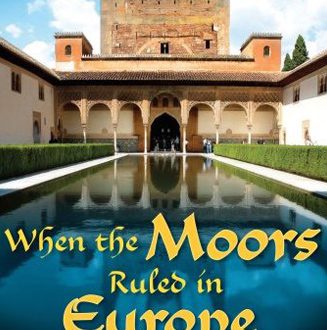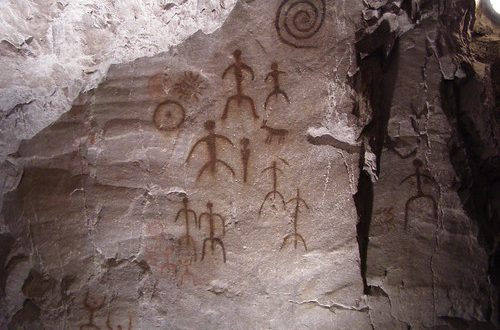The Staffordshire Hoard has been one of the most staggering and inspirational discoveries in British history. Hundreds of stunning gold Saxon artefacts, all bundled into one stash and found over a thousand years later by a lone metal detecting enthusiast – it’s a story that could have come straight out of an archaeological thriller. While the necessary steps are taken to secure their future, the treasures are being housed in Birmingham’s Museum and Art Gallery. Heritage Key talks to the museum’s resident scholar Dave Simmonds about his thoughts on a momentous breakthrough in British heritage.
HK: The Staffordshire Hoard is on display here how manic has it been since the artefacts arrived?
 DS: It’s just been incredible. I know that in the first days it drew about 15,500 people, and I think we’re going at about two to three thousand people per day right now. So it’s all hands on deck really we’re constantly having to juggle things and learn how to manage to queue. But I think we’ve got it more or less in order now. It’s been a steep learning curve in some senses though; I don’t think we really expected such a spectacular interest!
DS: It’s just been incredible. I know that in the first days it drew about 15,500 people, and I think we’re going at about two to three thousand people per day right now. So it’s all hands on deck really we’re constantly having to juggle things and learn how to manage to queue. But I think we’ve got it more or less in order now. It’s been a steep learning curve in some senses though; I don’t think we really expected such a spectacular interest!
HK: Has it surprised you how much the public has taken to the hoard?
DS: It has! I thought we would get national press coverage, and I thought we may get some sort of television coverage because it is an important find. But to be the lead item on the six o’clock BBC news, outdoing ‘Barack snubs Brown’ and an AIDS virus, was a little awe-inspiring. And then the queues have just not stopped. We’ve had people queuing for two to two-and-a-half hours to see this stuff, and they love it.
I think the other thing that’s surprised me slightly is how many people are fascinated by seeing it ‘mud and all’, because we can’t clean the material until it’s gone through the acquisitions process; until it belongs to a museum. So what’s up there are unclean pieces, and people love seeing the mud on them – they feel that they’re right there at the beginning of the tale of the hoard.
HK: Do you think a large part of their appeal is that they represent an era of British history which isn’t that well documented?
DS: There is an element of that to it – I think there’s a popular vision of the Saxons as hairy barbarians who dressed in furs and lived in holes in the ground. And I think the hoard is opening people’s eyes to the fact that, by the late 7th century, England is quite a civilised country. In the Saxon period England was probably the best-governed and one of richest kingdoms in Europe, which isn’t the picture our history books paint.
When the Normans came here, for example, they took over the Saxon way of doing things lock, stock and barrel, and the way the Saxons made their coins stayed the same completely they even kept the same people making the coins. And when you see coins being issued back in Normandy you can understand why, because they’re frankly terrible! So it wasn’t a case of civilisation being brought to these benighted islands these benighted islands were among the strongest and richest civilised countries in Europe.
There’s also the element of local pride because this is royal Mercia, and I’m fairly convinced we’re looking at a royal treasure hoard of some kind. And what it is is really open to interpretation. I think with this amount of gold it must at least belong to some very high level of aristocracy. You’re looking at evidence from right at the beginnings of the Kingdom of Mercia, just at the time when it’s rising to prominence as one of the great kingdoms of the Anglo-Saxons.
HK: Portable Antiquities have claimed that it’s only one of two things; a religious offering or a treasure trove which became lost. Do you agree with that?
DS: I suspect you’ll find opinions change as more people throw their ideas into the ring. A lot hinges on when the hoard was buried. This isn’t the same as how old most of the metalwork is, because it can only be as old as the latest thing in it. You could find a hoard of Victorian pennies, for example, but if there’s a 1990s pound in the hoard, then the hoard can’t have been buried until 1990.
On current showing I think a date in the late 7th century, around 700 seems to be the wise money. By then Mercia was a Christian kingdom, so if the hoard does belong to that stage I think it’s unlikely to be a sacrificial deposit by pagans. I think we’re probably looking at some sort of process of hiding it for safety that’s why you’d tend to bury a hoard like this.
Then you get the question, ‘What is the hoard?’ This is where you get even more unsure, because some of the pieces appear to span up to a hundred years. And if you’re looking at, say, swords covering decades, are you looking at an accumulation of material put together over decades? Or one big climactic battle where you have a group of nobles warriors who were all killed whilst using heirloom swords? Until the stuff is all cleaned to be properly studied, I think we’re all slightly floundering about because we just haven’t got the full evidence.
HK: What is the plan regarding its study?
DS: At the moment we’re all focusing on the next two phases. Initially it’s quite unusual for this hoard to be displayed here at the moment: normally, if it’s gone through a coroner’s inquest and been declared treasure, it will go straight to the British Museum which is where the valuation process takes place. But the British Museum have very kindly and quite unusually because of the nature of this find and its importance to the region agreed we can display some if it here for up to three weeks, before it goes down there.
Then it has to be assessed by something called the Treasure Valuation Committee, which is an independent committee including representatives of metal detecting world, museums, academics, antiquities trades and an independent chairman. They will then commission three valuations from leading antiquities dealers, which they use as advice for reaching a final value for the hoard.
Once that value is agreed – and the landowner and the finder both have to agree to the valuation – that’s what any interested museums will have to pay in terms of cash agreement. That payment then gets transferred to the finder and the landowner, and they split it between them. We are hoping that it will be ourselves and The Potteries Museum and Art Gallery, Stoke-on-Trent who will make a joint acquisition of the hoard. Then we have to raise the money, and we’re not thinking a great deal beyond that at this stage. It’s going to be quite a challenge, I suspect!
It’s another example of how the British Museum have been really supportive and really helpful. I’d like to give them a clap because they really have been excellent partners in all this.
HK: You’re pro-BM? Plenty of people resent the power they have.
DS: Yes, I mean you have to make a balance between the fact that they are the national collection, so inevitably they are likely to be the home of the most significant finds. But they have been working very hard to try to create partnerships to deal with that perception and certainly with this they’ve already said that they would prefer this material to stay in the Midlands, which is very good and they’ve already said they’ll help with any acquisition process. So there’s a really great partnership building here, and we’re very positive about it.
HK: Some have estimated it’s worth a million –
DS: All I can say is we’re expecting it to be a seven-figure sum and beyond that I wouldn’t even try to guess. But we’re hopeful: there’s this massive popular interest; and it is an internationally important hoard, so we would sincerely hope there will be assistance from funding bodies. But again, I can’t really say more than that at this stage we’ll certainly be going all-out to keep the material in the West Midlands region.
HK: When did you first get wind of the discovery?
DS: I heard about it very early. I was actually involved in another exhibition at the time, so I didn’t have much of a chance to get heavily involved. I knew there was a hoard back in July, and it was really only in August that I got a chance to look at the material and it was…well the three words I’ve been using most are astonishing, amazing and incredible, and all three of those apply. You looked in one box and thought, ‘Wow’, then you looked in another box and thought, ‘Double wow’ and it just got better and better, and you were seeing things you just couldn’t believe. Some of the stuff is astonishing, and the quality of some of the items is as good as, if not better than, those at the Sutton Hoo burial.
We must be talking royal workshops here. And then there are these wonderful personal touches in some of the finds. To me, the thing I’d have if given the chance is this wonderful folded-up Christian cross. It doesn’t sound terribly exciting it’s a gold cross that’s been folded into a lump, essentially, and most of the mounts that once held its precious or semi-precious stones have fallen off.
We’ve actually got the mounts – they’re in the hoard. Actually we’ve got the whole thing, but it’s essentially just this folded ball of cross and a few pieces that have dropped off. Which doesn’t sound too impressive: but we got one of our technicians to do a reconstruction and painting of it, and the thing would have been astonishing I think it was the processional cross on the end of a long staff. But what really appeals to me is that when you look at the mounts you can see that they had a kind of tooth border, and you can see where the border’s been pulled back to take the stones out. So it’s quite obvious they actually recycled the stones except for one garnet, which is silver.
But the garnet broke in Saxon times, and it’s now held in place with a little strip of gold along one edge, which kept it in position as a Saxon running repair. They obviously took one look at this and thought, ‘There’s no point taking that out, it’s broken,’ and there wouldn’t be any point in recycling it so they just left it there. So there you’ve got an incredible little human story you can see in just those two or three pieces on the cross.
The more you look, the more you find these stories, and the more you start seeing parallels with other stuff. Or you suddenly realise you’re looking at things that are different, that are new, and that’s one of the interesting things that’s going to come out of this hoard. There are already pieces that we’ve had specialist experts in Saxon metalwork looking at and saying, ‘We have no idea what they are.’ So there’s going to be so much coming out of this in the next two or three years.
HK: In that sense, and of the drama of its discovery, is it a more important find than Sutton Hoo?
DS: I would say that it’s of the same level as Sutton Hoo. It’s going to make us re-evaluate Sutton Hoo, because Sutton Hoo was simply unique and now there’s this massive extra source of elaborate gold work. We’ve got stuff that looks very much like Sutton Hoo material, but with Sutton Hoo they had around 45 pieces of gold, some of them very dramatic: we’re running into several hundred already. So this is going to throw wide open the field of study for this kind of material, and I think what we learn from this will enable people to look back on the Sutton Hoo find. It’s possibly not got as dramatic stuff as Sutton Hoo, but in terms of quantity and depth it’s probably better. So I would say on balance it’s as good as Sutton Hoo.
HK: And I guess you can cross-refence Saxon kingdoms easier now –
DS: Well that raises another question. People might say, ‘That’s East Anglian metalwork because we’ve found x-style stuff from Sutton Hoo.’ But that’s because there wasn’t anything else – I mean, if we’ve got another 40 pieces of the same style of metalwork from Mercia, you start asking yourself, ‘Is that actually from a Mercian school, and some of it went to East Anglia? Or is it an East Anglian school, and some if it’s come to Mercia? Or what?’ That’s what I mean about re-evaluating things. We’ve had to make assumptions based on evidence, but the evidence has just multiplied several times over. There’ll be a lot of re-thinking going on.
HK: Does it also imply Britain wasn’t quite as fragmented as was previously thought?
 DS: I think there’s a kind of common warrior-aristocrat culture. If you were a 7th century king of Mercia, you probably had more in common with a 7th century king of East Anglia in terms of your lifestyle and ethos than you did with a peasant working on a field in Mercia. So there is a kind of common heroic world. Again, we are seeing styles which are very unusual, so we definitely are wondering if there is a Mercian school of goldworking which wouldn’t be a surprise.
DS: I think there’s a kind of common warrior-aristocrat culture. If you were a 7th century king of Mercia, you probably had more in common with a 7th century king of East Anglia in terms of your lifestyle and ethos than you did with a peasant working on a field in Mercia. So there is a kind of common heroic world. Again, we are seeing styles which are very unusual, so we definitely are wondering if there is a Mercian school of goldworking which wouldn’t be a surprise.
Mercia is one of the great kingdoms of the Anglo-Saxon world. The 7th century is the exact time that Mercia is rising to dominance – it ends up ruling everything from the Humber to the Thames; a big kingdom. In the next century of course we have King Offa, probably one of the most famous Saxon kings people have heard of, and he’s a king of Mercia. So there is a powerful rich kingdom here, and now suddenly we’ve got the evidence for it in terms of its archaeology. And this hoard comes from just a few miles from Tamworth in Staffordshire which is the royal capital of the Mercians, and from Litchfield in Staffordshire which is the ecclesiastic capital of the Mercians. It’s right in the area you’d expect there to be a concentration of wealth of this kind.
HK: This hoard is just one of glut of amateur finds in the past few weeks. What is your view on metal detecting?
DS: If it’s done responsibly I think it’s quite reasonable, and most metal detectors are responsible people. I think nowadays we’re mainly over the large squabbles. Inevitably there are the night-hawks and the out-and-out rogues who are there to make a buck and really don’t care, but they’re the sort of people responsible metal detectors don’t like either. And to be fair there are some archaeologists who harbour quite extreme views the other side.
In typical British fashion I think the middle way is probably the best because it works, and is seen to be working this hoard is a case in point. If this had not been found now and that field had been ploughed for two or three more years, a lot of this stuff would be in pieces, or more pieces than it is. So Terry’s find was just at the right time; he did the responsible thing. Within the first few days of seeing the first thing he was in contact with a finds liaison officer here, who then did exactly the right thing and contacted the local archaeological authorities in Staffordshire. There was an excavation that uncovered a lot more material, and everybody’s done exactly what they should have done and has worked together brilliantly.
People probably don’t realise quite what an achievement this is. The first find was made on the fifth of July, and on the 24th September is the inquest, which I think is about eleven weeks. That’s included the find, the reporting, four weeks of excavation and the Portable Antiquities official listing 1,381 pieces by the time of the inquest! So to get all that done, and to have kept the site and hoard secret it’s been an astonishing achievement the news only really started to come out the night before the inquest. You really couldn’t have asked for the process to have gone better, it’s been a fantastic thing to be involved in.



